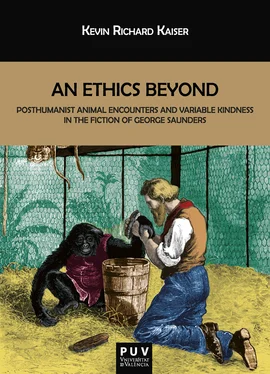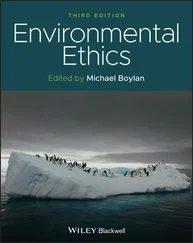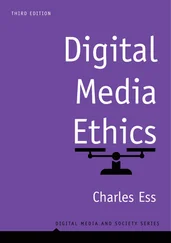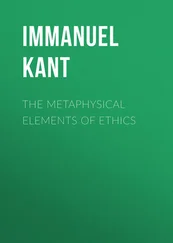In his well-received essay, “E Unibus Pluram: Television and U.S. Fiction,” 9originally published in 1993 in The Review of Contemporary Fiction and collected in A Supposedly Fun Thing I’ll Never Do Again (1997), Wallace writes that “irony, poker-faced silence, and fear of ridicule are distinctive features of contemporary U.S. culture (of which cutting-edge fiction is a part) that enjoy any significant relation to the television whose weird pretty hand has my generation by the throat” (171). He also contends that his intention is “to argue that irony and ridicule are entertaining and effective, and that at the same time they are agents of great despair and stasis in U.S. culture, and that for aspiring fictionists they pose terrifically vexing problems” (EUP 171). Saunders’s Civilwarland in Bad Decline , a collection of stories and a novella published a few years after this essay appeared, introduced a writer whose fiction looked both backward and forward at once, while somehow still connecting with the present culture that Wallace describes. Over the next two decades, and increasingly after 9/11, television culture would give way to Internet culture, one in which the American president could win an election by openly attacking Muslims, Mexicans, women—anyone considered the Other—and by being a parody and caricature of himself, meanwhile complaining about the ridicule he receives via Internet media.
Wallace offers two main premises in “E Unibus Pluram,” the first point being that “a certain subgenre of pop-conscious postmodern fiction, written mostly by young Americans, has lately arisen and made a real attempt to transfigure a world of and for appearance, mass appeal, and television,” which seems positive, except that, as his second point indicates, “televisual culture has evolved to a point where it seems invulnerable to any such transfiguring assault” (171). The same can be said of our current technoculture, although, unlike television, it offers us new ways to read. Saunders’s Fox 8 originally was available only as a Kindle Single. While he still publishes print books, Saunders’s work, like that of most contemporary authors, is also readily available in electronic formats: Kindle Editions, online archives, audiobooks—forms which were unavailable or less readily available to David Foster Wallace.
We need not think strictly in terms of the influence of technoculture, however. If contemporary American culture is to be saddled with any modifier, it is more a culture of immediacy. Saunders is regarded for his short stories and novellas; his first novel only appeared after four collections of short fiction. While the American short story has become a praised form, despite the hesitation of publishers to print or promote it, Saunders, without slighting the caliber of his work, may benefit from living in a culture that demands immediacy. His first novel, Lincoln in the Bardo (2017), is ambitious but makes fewer demands on the reader’s time and attention span than novels on the grand scale of Wallace’s Infinite Jest (1993), Don DeLillo’s Underworld (1997), and Thomas Pynchon’s Gravity’s Rainbow (1973). Although Saunders has stated that he was compelled to write the novel, he has always thought of himself as a short fiction author. Even his essays often tend to read more like short stories than essay. Saunders’s shortest text fits on a paper bag—thanks to its publisher, Chipotle. Is this selling out? Is it irony? Unquestionably, it is at least a way to engage more unlikely readers.
The writing of both Wallace and Saunders is as much informed by American culture as it is a response and challenge to it. Likewise, it is a response to the postmodern and, for Saunders (albeit not intentionally or consciously), to the posthuman. Wallace explains, in an oft-quoted response from a 1993 interview with Larry McCaffery, collected in Conversations with David Foster Wallace (2012), that “[i]rony and cynicism were just what the U.S. hypocrisy of the fifties and sixties called for,” and “what made the early postmodernists great artists” (48). The advantage of using irony, he notes, “is that it splits things apart, gets above them so we can see the flaws and hypocrisies and duplicates” (McCaffery 48). For Wallace, however, there is a point when irony no longer fulfills its purpose. The complication, he believes, “is that once the rules of art are debunked, and once the unpleasant realities the irony diagnoses are revealed and diagnosed, “then” what do we do? Irony’s useful for debunking illusions, but most of the illusion-debunking in the U.S. has now been done and redone” (McCaffery 48).
Postmodern irony becomes the goal to the exclusion of sentimentality or ethicality, a criticism that Wallace himself levies, justly or not, on the fiction of Brett Easton Ellis. Wallace, disturbed by the trend, contends that “[p]ostmodern irony and cynicism become an end in itself, a measure of hip sophistication and literary savvy. Few artists dare to try to talk about ways of working toward redeeming what’s wrong, because they’ll look sentimental and naïve to all the weary ironists” (McCaffery 48). Instead of liberating literature, a superfluous or unchecked use of irony and cynicism encage it. However, Wallace is not the only author who remedied the emotionless, unethical fiction that he attacked.
“Radical Kindness”: A Posthuman Literature of Compassion
Wallace was a key member of a new generation of writers whose writing is described as sincere and ethical while still using irony. In an important essay, “The New Sincerity” (2016), Adam Kelly claims that George Saunders’s writing is part of this broader artistic cultural trend known as the New Sincerity. Kelly describes the art associated with this trend as generally being “regarded as a sturdy affirmation of nonironic values” and demonstrating “a renewed taking of responsibility for the meaning of ones’ words,” as well as offering “a post-postmodern embrace of the ‘single-entendre’ principles invoked by Wallace” in “E Unibus Pluram” (198). He also suggests that the New Sincerity aesthetic is one shared by many of Wallace’s and Saunders’s peers, including Michael Chabon, Junot Díaz, Jennifer Egan, Dave Eggers, Dana Spiotta, and Colson Whitehead.
For such New Sincerity writers, Kelly argues that “the guarantee of the writer’s sincerity cannot finally lie in representation” (TNS 205). In what reads as a rather Derridean description, this means that “[w]hat happens off the page, outside representation depends upon the invocation and response of another; this other to whom I respond, and whose response I await, is for many New Sincerity writers, the actual reader of their text” (TNS 205). Sincerity is contingent upon the reader. Kelly claims that “in New Sincerity writing, the author and reader really do exist, which is to say they are not simply implied ” (TNS 206, italics original). Thus, New Sincerity writing must be understood “as a contingent rather than ideal process that recapitulates the struggle for communication differently and anew in each reading” (TNS 206). Saunders’s irony is not irony for the sake of irony but for the sake of response. How we, as readers, respond, how we feel “differently and anew in each reading,” is the mark of New Sincerity writing.
In an interview for Salon , Saunders admits that irony can be a way to honesty. He does not invoke irony to be honest; rather, by being honest, he is also often sarcastic. Like Wallace, he distinguishes between the uses of irony: “I think the irony or the humor that I like is stuff that is exactly what’s needed to drive that wedge into the truth, and the stuff that I don’t like is the superfluous kind of cleverness” (2014, n.p.). Wallace’s worries are alleviated by Saunders, who does not believe that sarcasm and compassion are mutually exclusive. In an interview for The Missouri Review , Saunders explains that sarcasm and compassion are “manifestations of the same impulse,” with compassion being what he calls “plain sight. If you see something plainly, without attachment to your own preconceptions of it and without any aversion to what you see, that's compassion because you're minimizing the distinction between subject and object . Then whatever needs to be done, you can do it quickly and efficiently, to address whatever the suffering” (2001, 56, italics my own).
Читать дальше












